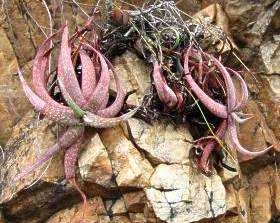Aloe pictifolia
Aloe pictifolia D.S.Hardy
Family: Asphodelaceae
Common names: Kouga -aalwyn (Afr.), Kouga aloe (Eng.).
Introduction
An attractive small aloe with greyish-green leaves ornamented with many white spots. It is easily grown and popular in cultivation.

Description
Description
Plants usually form small groups of up to seven rosettes up to 200 mm in diameter with a short ascending to hanging stem The narrowly spear-shaped leaves are up to 150 mm long but no wider than about 25 mm at the base. Both surfaces are densely covered with white spots. Normally the leaves are greyish-green but they turn pinkish-green under drought stress. At first they are arranged in opposite rows (distichous) but later form rosettes. In plants growing in a level position the leaves are ascending or curve inwards but they become recurved when the stem is hanging. The leaf margins are armed with small reddish teeth. The tip of the leaf is drawn into a sharp point ending in a prickle (mucro). The inflorescence is unbranched, erectly spreading, laxly flowered and up to 350 mm high. The flowers are about 16 mm long, reddish pink with a yellow mouth, and are pendulous when open. Capsules are about 15 mm long and 6 mm in diameter. The seeds are angular, grey-black and up to 4 x 2 mm.

Conservation Status
Status
Aloe pictifolia is restricted to a small area where it is well protected due to the inaccessible, sheer rock faces on which it grows. The plant is also well established in cultivation (ex situ conservation) and is grown by succulent plant growers all over the world.
Distribution and habitat
Distribution description
Aloe pictifolia is confined to quartzitic sandstone cliffs (all aspects) overlooking the Kouga River near Hankey in the Eastern Cape. The average daily maximum temperature of the area is about 25ºC and the average daily minimum about 10ºC. Winters are cooler but frost is a rarity or absent. Rainfall occurs during winter and summer and ranges between 400 and 500 mm per annum.

Associated succulents in its habitat include: Cyrtanthus flammosus, C. montanus, Gasteria glomerata, Haworthia gracilis var. picturata, H. viscosa, Plectranthus verticillatus, Othonna lobata, Cotyledon tomentosa subsp. tomentosa, Crassula rupestris subsp. rupestris 'Kouga form' and Adromischus cristatus var. zeyheri. Plants grow at an altitude of 250-500 m in Gamtoos Thicket of the Albany Thicket Biome.

Derivation of name and historical aspects
History
The specific epithet (pictifolia) pertains to its white-spotted leaves (pictus = painted, and folium = leaf). The species was first collected by a Mr Marais on cliffs adjacent to the Kouga Dam (Patensie District, E. Cape). It was named by Mr Dave Hardy (24 September 1931-31 May 1998), former horticulturist at the then Botanical Research Institute in Pretoria.
Ecology
Ecology
Aloe pictifolia flowers during spring (October to November), but sporadically also at other times. Plants are pollinated by sunbirds and seeds are wind-dispersed. The plants grow on quartztic sandstone ledges in full sun or partial shade. When growing pendent from crevices the leaves recurve and when growing erectly the leaves are ascending to incurved. Plants are initially solitary but the rosettes divide to form small to dense clusters. During wet conditions the leaves become very turgid and almost rounded (subterete); during dry spells they become flattened and reddish-tinged.
Uses
Use
It is popular in cultivation and is not used medicinally.
Growing Aloe pictifolia
Grow

Aloe pictifolia is an atractive small plant best grown in Thicket Gardens. It is an easy grower, and can be planted in full sun or partial shade. Propagation is easy, from both division or seed and plants thrive in small containers. Seed germinates within 3 weeks and plants will flower in the third year. In areas where frost is experienced, it is best grown as a container subject in a greenhouse under controlled environmental conditions.
References
- Glen, H.F. & Hardy, D.S. 2000. Aloaceae (first part): Aloe. Flora of southern Africa 5,1,1. National Botanical Institute, Pretoria.
- Hardy, D.S. 1976. A new species of Aloe from the Humansdorp District. Bothalia 12: 62.
Credits
Ernst van Jaarsveld
Kirstenbosch National Botanical Garden
28 July 2008
Plant Attributes:
Plant Type: Succulent
SA Distribution: Eastern Cape
Soil type: Sandy
Flowering season: Spring, Winter
PH: Acid
Flower colour: Orange
Aspect: Full Sun, Shade, Morning Sun (Semi Shade), Afternoon Sun (Semi Shade)
Gardening skill: Easy
Special Features:
Horticultural zones











Rate this article
Article well written and informative
Rate this plant
Is this an interesting plant?
Login to add your Comment
Back to topNot registered yet? Click here to register.